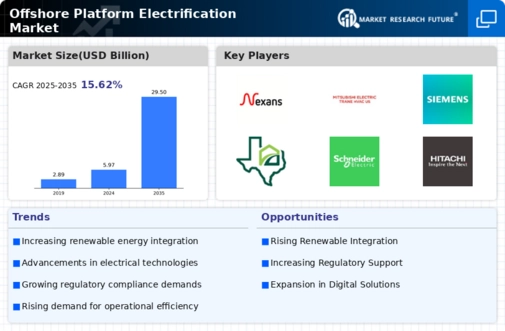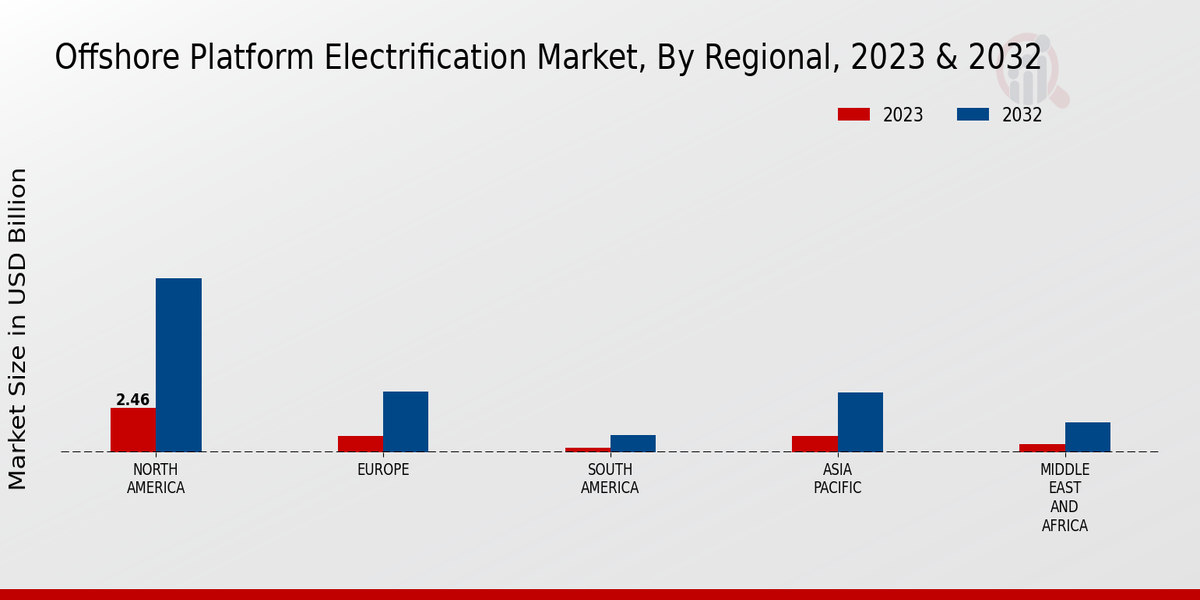Market Growth Projections
The Global Offshore Platform Electrification Market Industry is on a trajectory of substantial growth, with projections indicating a market value of 5.97 USD Billion in 2024 and an anticipated increase to 29.5 USD Billion by 2035. This growth is underpinned by a compound annual growth rate (CAGR) of 15.62% from 2025 to 2035. The increasing demand for sustainable energy solutions, coupled with advancements in electrification technologies and supportive regulatory frameworks, is likely to drive this expansion. As the industry evolves, stakeholders are expected to invest significantly in electrification projects, further solidifying the market's position in the global energy landscape.
Regulatory Support and Incentives
Government policies and regulations significantly influence the Global Offshore Platform Electrification Market Industry. Many nations are implementing stringent regulations aimed at reducing greenhouse gas emissions, which in turn encourages the electrification of offshore platforms. Incentives such as tax breaks, grants, and subsidies for renewable energy projects are becoming increasingly common. For example, the European Union has set ambitious targets for carbon neutrality by 2050, which necessitates a shift towards electrified offshore operations. This regulatory environment not only fosters innovation but also attracts investments, thereby propelling the market forward at a projected CAGR of 15.62% from 2025 to 2035.
Rising Demand for Renewable Energy
The Global Offshore Platform Electrification Market Industry is experiencing a notable shift towards renewable energy sources. As countries aim to reduce carbon emissions, offshore platforms are increasingly electrified using wind and solar energy. This transition is not only environmentally beneficial but also economically advantageous, as it reduces operational costs over time. For instance, the integration of renewable energy into offshore platforms can lead to a reduction in fuel consumption by up to 30 percent. This growing emphasis on sustainability is projected to contribute significantly to the market's expansion, with the market value expected to reach 5.97 USD Billion in 2024.
Increasing Offshore Oil and Gas Exploration
The Global Offshore Platform Electrification Market Industry is also driven by the rising activities in offshore oil and gas exploration. As energy demand continues to grow globally, companies are investing in new offshore projects, necessitating the need for efficient and sustainable electrification solutions. The electrification of these platforms can enhance operational efficiency and reduce reliance on traditional fossil fuels. For instance, electrified platforms can operate more reliably in harsh marine environments, which is crucial for maintaining production levels. This trend is expected to contribute to the overall market growth, aligning with the projected increase in market value to 29.5 USD Billion by 2035.
Technological Advancements in Electrification
Technological innovations play a crucial role in the Global Offshore Platform Electrification Market Industry. The development of advanced electrical systems, such as high-voltage direct current (HVDC) technology, enhances the efficiency and reliability of offshore electrification. These advancements facilitate the integration of various energy sources and improve the overall performance of offshore platforms. Moreover, the adoption of smart grid technologies allows for better energy management and distribution. As a result, the market is likely to witness a surge in investments in electrification technologies, further driving growth and potentially leading to a market valuation of 29.5 USD Billion by 2035.
Focus on Operational Efficiency and Cost Reduction
Operational efficiency and cost reduction are paramount in the Global Offshore Platform Electrification Market Industry. Companies are increasingly recognizing that electrification can lead to substantial savings in operational costs. By transitioning to electrified systems, offshore platforms can minimize fuel consumption and reduce maintenance costs associated with traditional power generation methods. For instance, studies indicate that electrification can lower operational costs by approximately 20 percent over time. This focus on efficiency is driving investments in electrification technologies, as companies seek to enhance their competitiveness in a rapidly evolving energy landscape. As a result, the market is poised for significant growth, with a projected CAGR of 15.62% from 2025 to 2035.






















